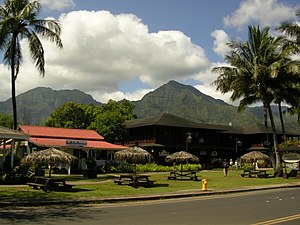Kauai Real Estate Detail
German immigrant Hermann A. Widemann (1822–1899) started one of the first sugar plantations in Hawaii known as Grove Farm in 1854. During the American Civil War, the demand for Hawaii sugar grew, but Widemann supported the Confederate States.[2]:180 After leasing Grove Farm to its manager George Norton Wilcox (1839–1933) in November 1864,[3] Widemann moved to Honolulu to work in the capital as a supreme court judge. Wilcox would later buy the plantation, and it remained in the family for over 100 years. Wilcox had an irrigation system built to bring water from the wet mountains to the flatter lower elevations where the crops were grown. This idea was later copied by many other planters in the islands.
In 1881 Princess Ruth Keʻelikolani sold some adjoining land, which grew the acreage by about a factor of ten. In 1903 the family hired Charles William Dickey to design a house for Ralph Wilcox and his wife Daisy Rice. Dickey also supervised a renovation of the main house in 1915 which removed interior walls to create large open spaces.[4] From 1913 to 1917 a row of small houses were built for plantation workers. The houses were called Kaipu Camp after the Hawaiian name for a Chinese foreman of the plantation.[5]
The main estate house has two bedrooms, writing room, two bathrooms, and a library on the first floor. A grand staircase leads up to the second floor which has more bedrooms. Behind the main house is a hexagonal gazebo styled after a Japanese teahouse, built in 1898. To the south is a guest cottage with two living areas from about 1890. Another single story cottage was built in 1877 for George Wilcox, and an office building was built in 1884. A number of support buildings include sheds and a garage.[4]
German immigrant Hermann A. Widemann (1822–1899) started one of the first sugar plantations in Hawaii known as Grove Farm in 1854. During the American Civil War, the demand for Hawaii sugar grew, but Widemann supported the Confederate States.[2]:180 After leasing Grove Farm to its manager George Norton Wilcox (1839–1933) in November 1864,[3] Widemann moved to Honolulu to work in the capital as a supreme court judge. Wilcox would later buy the plantation, and it remained in the family for over 100 years. Wilcox had an irrigation system built to bring water from the wet mountains to the flatter lower elevations where the crops were grown. This idea was later copied by many other planters in the islands.
In 1881 Princess Ruth Keʻelikolani sold some adjoining land, which grew the acreage by about a factor of ten. In 1903 the family hired Charles William Dickey to design a house for Ralph Wilcox and his wife Daisy Rice. Dickey also supervised a renovation of the main house in 1915 which removed interior walls to create large open spaces.[4] From 1913 to 1917 a row of small houses were built for plantation workers. The houses were called Kaipu Camp after the Hawaiian name for a Chinese foreman of the plantation.[5]
The main estate house has two bedrooms, writing room, two bathrooms, and a library on the first floor. A grand staircase leads up to the second floor which has more bedrooms. Behind the main house is a hexagonal gazebo styled after a Japanese teahouse, built in 1898. To the south is a guest cottage with two living areas from about 1890. Another single story cottage was built in 1877 for George Wilcox, and an office building was built in 1884. A number of support buildings include sheds and a garage.[4]
Kauai Real Estate
Kauai Real Estate
Kauai Real Estate
Kauai Real Estate
Kauai Real Estate
Kauai Real Estate
Kauai Real Estate
Kauai Real Estate
Kauai Real Estate
Kauai Real Estate
Kauai Real Estate
Kauai Real Estate












No comments:
Post a Comment